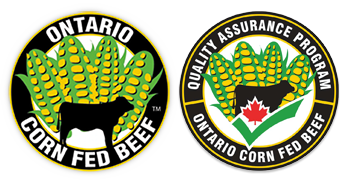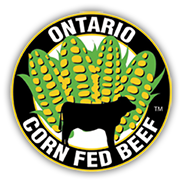“The News Feed Live” Webinar Series #4 – “Sustainable Corn Production For Ontario’s Farmer/Feeder”
The latest “News Feed Live” webinar showcased the strong connection to sustainable production practices in our Ontario Corn Fed Beef Quality Assurance Program. Entitled “Sustainable Corn Production for Ontario’s Farmer/Feeder,” OCFB producers and invited experts shared their methods, management guidelines and benefits from incorporating improved feed growing and fertility practices on an OCFB feedlot operation.
Once again, we were pleased to collaborate with the Ontario Ministry of Agriculture, Food and Rural Affairs on the March 9th webinar. While this article provides a few highlights, we encourage anyone interested in learning more to view the webinar on our YouTube channel or on the Ontario Corn Fed Beef website.
Why produce a webinar on sustainable corn production?
The OCFA Quality Assurance program continues to be recognized as the foundation of the Ontario Corn Fed Beef brand, advocating good management practices and good production practices for quality feed and cattle production.
Ontario’s corn crop is a mainstay for livestock feed and ethanol production in the province. Corn is also the reason consumers support OCFB’s great taste and flavour enhanced by Ontario corn.
However, customers/consumers have recently been asking additional questions and want to know more about the OCFB production story.
These questions include: how are farmers being good stewards of the land, how are cattle being sustainably raised on farms, how are farmers protecting groundwater sources etc.?
Producers are striving to adopt and implement the best management practices on their farms involving crops and cattle production. Examples are minimum tillage methods, cover crops, fertility programs using manure and fertilizer matching crop yield potential and both maximizing feed quality and having detailed animal health protocols for cattle.
Producers continually look at ways they can improve. “After all, it’s their livelihood and the financial security for their family and employees,” said Brent Cavell, OCFA/OCFB Quality Assurance Manager. “It’s their commitment to creating a vibrant, local agricultural value chain to support their community and its members.
Ontario farmer feeders have a huge, vested interest in producing crops and cattle as efficiently as possible, particularly now with production costs for both being at all-time highs.”
Christoph Wand, OMAFRA Livestock Sustainability Specialist, noted the importance of demonstrating the linkages between the land-based producers because much of the cropping footprint is in their hands. “In livestock, the footprint in many cases is tied to the feedstuffs we buy or grow,” said Wand. “(Having) a good feeding system and a good growing system is a very good outcome. We need to work in both of those areas.”
The term “Ontario farmer/feeders” provides a great storyline to expand on, focusing on the family farm growing crops to feed their cattle, which produce manure and nutrients to return to the land to grow crops, thus continuing the cycle. This represents a very sustainable production model. “I think that is something that the consumers can latch onto, and it also puts some definition into the word sustainability in our world here,” added Cavell.
We have a simple system yet comprehensive story to tell about the farmer/feeder production cycle, something the consumer will no doubt be able to relate to very well. The producers in our webinar videos describe what they implement on their farms resulting in a great consumer-friendly story in response to their many questions.
The interrelationship between crop rotation, record-keeping and feed costs became evident during the preparation for the previous webinar on financial management. “If livestock people don’t talk about how cropping systems perform specifically in a livestock context, nobody else will,” said Wand, explaining the aim of offering the context for ‘farmer/feeders.’
Nitrogen management
The webinar featured presentations from Ben Rosser, OMAFRA Corn Specialist, Deb Campbell of Agronomy Advantage Inc., Darrell Russett of Russett Farms and Scott Cochrane of Cochrane Farming Inc.
On sustainable corn production, Rosser focused on sharpening management skills, given the attention paid to nitrogen in terms of reducing emissions. “One of the big things about managing nitrogen is applying the right rate, “said Rosser. “Of all the things you can do to manage nitrogen emissions, the right rate has the biggest impact on reducing emissions.”
Rosser recommended some online tools for optimizing rates, including the corn nitrogen calculator at GoCorn.net.
Another key management site is OMAFRA’s Agri Suite. It’s the Ontario government’s free agricultural and environmental suite of decision support tools for crop management, nutrient management and minimum distance separation. It can be found at https://agrisuite.omafra.gov.on.ca/
Manure management
Deb Campbell discussed several aspects of manure management, noting that the topic is strongly tied to farm nutrient stewardship. “It’s become an underpinning concept any time you’re talking about nutrients,” said Campbell. “Whether nitrogen, phosphorus, or manure, it’s all cornerstone nutrient stewardship. I think most of you would be familiar with these concepts of the right source, the right rate, the right time and the right place.”
If the primary source of nutrients is manure, producers need to have a good handle on how it tests and the various nutrient levels in the mix. “Those manure analyses are really important to know the whole nutrient balance on the farm,” she added. “A bunch of labs will also tell you if your nitrogen is responding, based on how quickly you’re incorporating it, whether you’re injecting it, or whether you’re applying it in the fall or the spring. It gives you a lot of value in terms of knowing what you’re applying.”
Producer comments
Darrell Russett shared his methods from his farm near Stirling, Ont., in Hastings County. Two-thirds of the land is dedicated to the cattle operation, and the remaining third is for cash crops. Noting that they grow 700 acres of corn, Russett said the ground gets a coat of manure. They also plant 140 acres of no-till beans in 30-inch rows. Again, the ground receives manure before the beans are planted. The bean straw is then used for bedding packs. They also plant 150 acres
of wheat annually, no-tilled into corn silage ground after a coat of manure.
Russett spent a few minutes discussing their experience with planting rye in the fall. He said the density of the rye is fairly thick in the spring, which gives their cows a good area to calve and where the disease pressure is low. “After the fall rye’s density is established, we’ll spread manure on that again in the spring before it starts to grow,” he said. “Once the growth is there, we cut it, and it’s all ready for planting corn. We wait until it heads because we don’t need the
protein; we need the fibre.”
Producer Scott Cochrane highlighted his experience with strip tillage on the family farm near Paris, Ont. He has been pleased with the strip-till results, particularly on the corn-on-corn ground. “Sometimes you just have to use corn-on-corn in a livestock operation in order to get enough feed for the livestock,” he said. “When we’re trying to disc or cultivate corn stalks in order to plant again, there’s too much trash around the seed. This way, you drive down in between the rows (from last year), and you get a nice blank strip between, and the corn planter does a nice job of planting on top of that. With corn-on-corn, we’ve got very good emergence
when we got rid of the trash and planted between the rows.”
Cochrane added that strip tillage is also helpful when planting into their manure pack spread on the fields. He noted that it could be a difficult process as the pack can have quite a bit of straw due to their backgrounding cattle. “The strip-tiller moves that trash into the centre, and that leaves a perfectly blank strip to plant into in between the rows,” he said.
Russett and Cochrane were interviewed on their farms, where videos were produced to help capture their cropping methods. Again, we encourage people to view the webinar online to fully. appreciate their experiences and get the full presentations from Ben Rosser and Deb Campbell.

